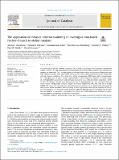Files in this item
The application of inelastic neutron scattering to investigate iron-based Fischer-Tropsch to olefins catalysis
Item metadata
| dc.contributor.author | Davidson, Alisha L. | |
| dc.contributor.author | Gibson, Emma K. | |
| dc.contributor.author | Cibin, Giannantonio | |
| dc.contributor.author | van Rensburg, Hendrik | |
| dc.contributor.author | Parker, Stewart F. | |
| dc.contributor.author | Webb, Paul B. | |
| dc.contributor.author | Lennon, David | |
| dc.date.accessioned | 2020-11-02T13:30:03Z | |
| dc.date.available | 2020-11-02T13:30:03Z | |
| dc.date.issued | 2020-12 | |
| dc.identifier | 270725230 | |
| dc.identifier | 1f02737b-1b3e-4ac5-9ab7-087d19f69924 | |
| dc.identifier | 85094595289 | |
| dc.identifier | 000598540500023 | |
| dc.identifier.citation | Davidson , A L , Gibson , E K , Cibin , G , van Rensburg , H , Parker , S F , Webb , P B & Lennon , D 2020 , ' The application of inelastic neutron scattering to investigate iron-based Fischer-Tropsch to olefins catalysis ' , Journal of Catalysis , vol. 392 , pp. 197-208 . https://doi.org/10.1016/j.jcat.2020.09.025 | en |
| dc.identifier.issn | 0021-9517 | |
| dc.identifier.other | RIS: urn:A46FA6C1D9748355A4CDC80106E9E07F | |
| dc.identifier.other | ORCID: /0000-0003-2532-344X/work/82179786 | |
| dc.identifier.uri | https://hdl.handle.net/10023/20881 | |
| dc.description | Sasol Ltd., the University of Glasgow and EPSRC [award reference EP/P505534/1.] are thanked for the provision of postgraduate studentship (ALD). The STFC Rutherford Appleton Laboratory is thanked for access to neutron beam facilities [RB 1520269/1610413]. Diamond Light Source is thanked for time on B18 beamline through the Catalysis Hub BAG application (SP15151 and rapid access beamtime SP18431). The Royal Society is thanked for the provision of an Industry Fellowship (PBW). | en |
| dc.description.abstract | The technique of inelastic neutron scattering (INS) is used to investigate how hydrogen is partitioned within a series of Na and S promoted iron-based Fischer-Tropsch-to-olefin catalysts. Two reaction test regimes are examined. First, reaction testing at elevated temperature and pressure demonstrate how Na/S additions enhance short chain olefin selectivity and reduce methane formation under industrially relevant reaction conditions. For a fixed level of Na incorporation (2000 ppm), sulfur concentrations of ≤ 100 ppm result in only a modest improvement in olefin selectivity. However, for sulfur values of ≥ 100 ppm there is a noticeable and systematic increase in C2-C4 olefin selectivity; rising from ∼30.0 % to 35.2% at 250 ppm. Second, using ambient pressure CO hydrogenation as a test reaction in INS and micro-reactor configurations, catalyst samples are further analysed by TPR, TPO, XRD and S K-edge XANES. INS shows the formation of a hydrocarbonaceous overlayer to be significantly attenuated by the presence of the promoters, with increasing S levels significantly reducing the intensity of the sp2 and sp3 hybridised ν(C-H) modes of the overlayer, albeit to differing degrees. A probable role for how this combination of promoters is perturbing the form of the hydrocarbonaceous overlayer to subsequently moderate the product distribution is considered. | |
| dc.format.extent | 12 | |
| dc.format.extent | 2207876 | |
| dc.language.iso | eng | |
| dc.relation.ispartof | Journal of Catalysis | en |
| dc.subject | Fischer-Tropsch-to-olefins catalysis | en |
| dc.subject | Inelastic neutron scattering | en |
| dc.subject | XANES | en |
| dc.subject | Chemical modifiers | en |
| dc.subject | QD Chemistry | en |
| dc.subject | 3rd-DAS | en |
| dc.subject.lcc | QD | en |
| dc.title | The application of inelastic neutron scattering to investigate iron-based Fischer-Tropsch to olefins catalysis | en |
| dc.type | Journal article | en |
| dc.contributor.sponsor | The Royal Society | en |
| dc.contributor.institution | University of St Andrews. School of Chemistry | en |
| dc.identifier.doi | https://doi.org/10.1016/j.jcat.2020.09.025 | |
| dc.description.status | Peer reviewed | en |
| dc.identifier.grantnumber | IF140013 | en |
This item appears in the following Collection(s)
Items in the St Andrews Research Repository are protected by copyright, with all rights reserved, unless otherwise indicated.

